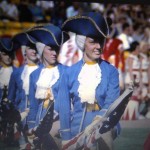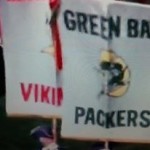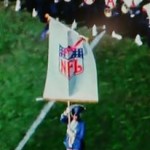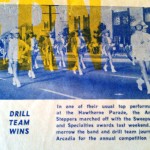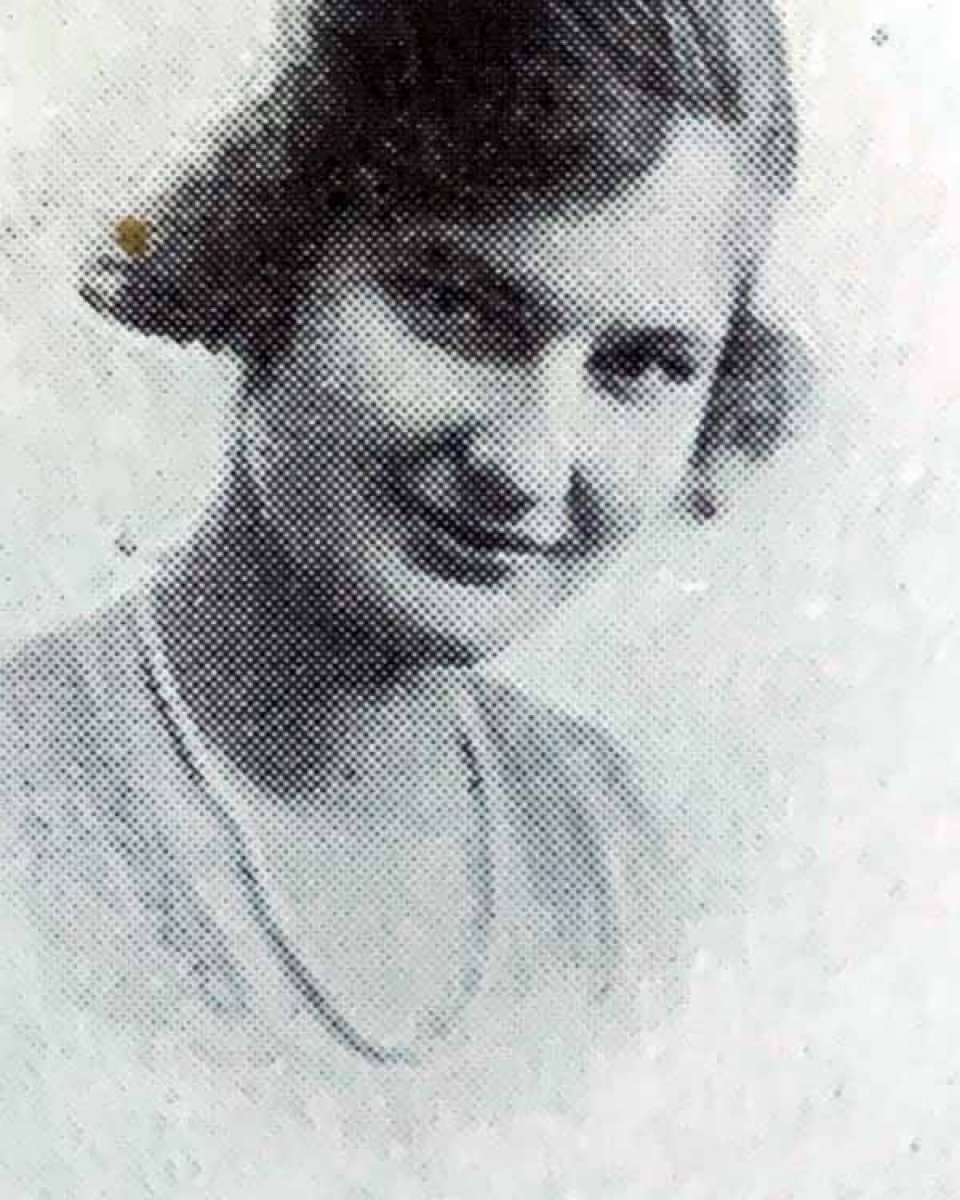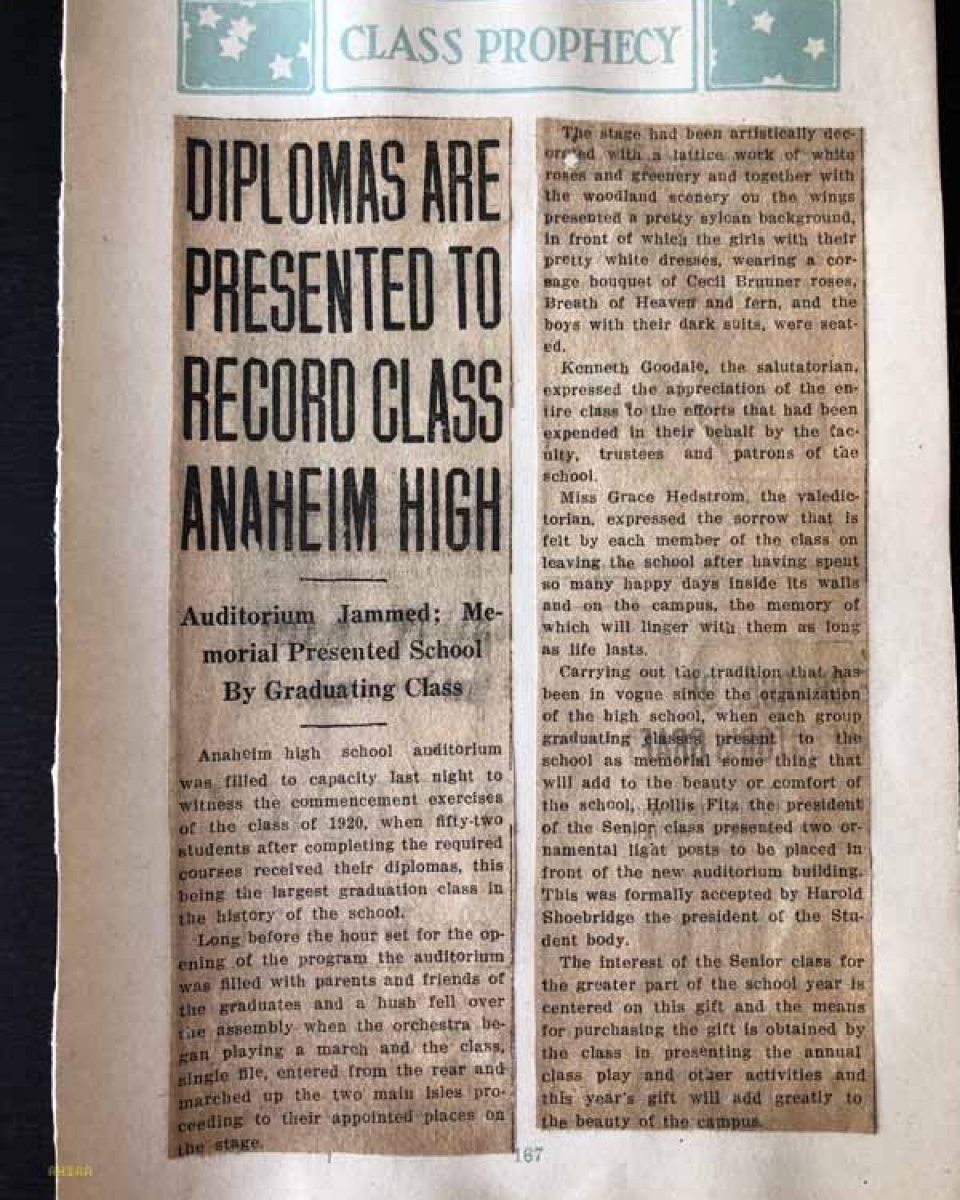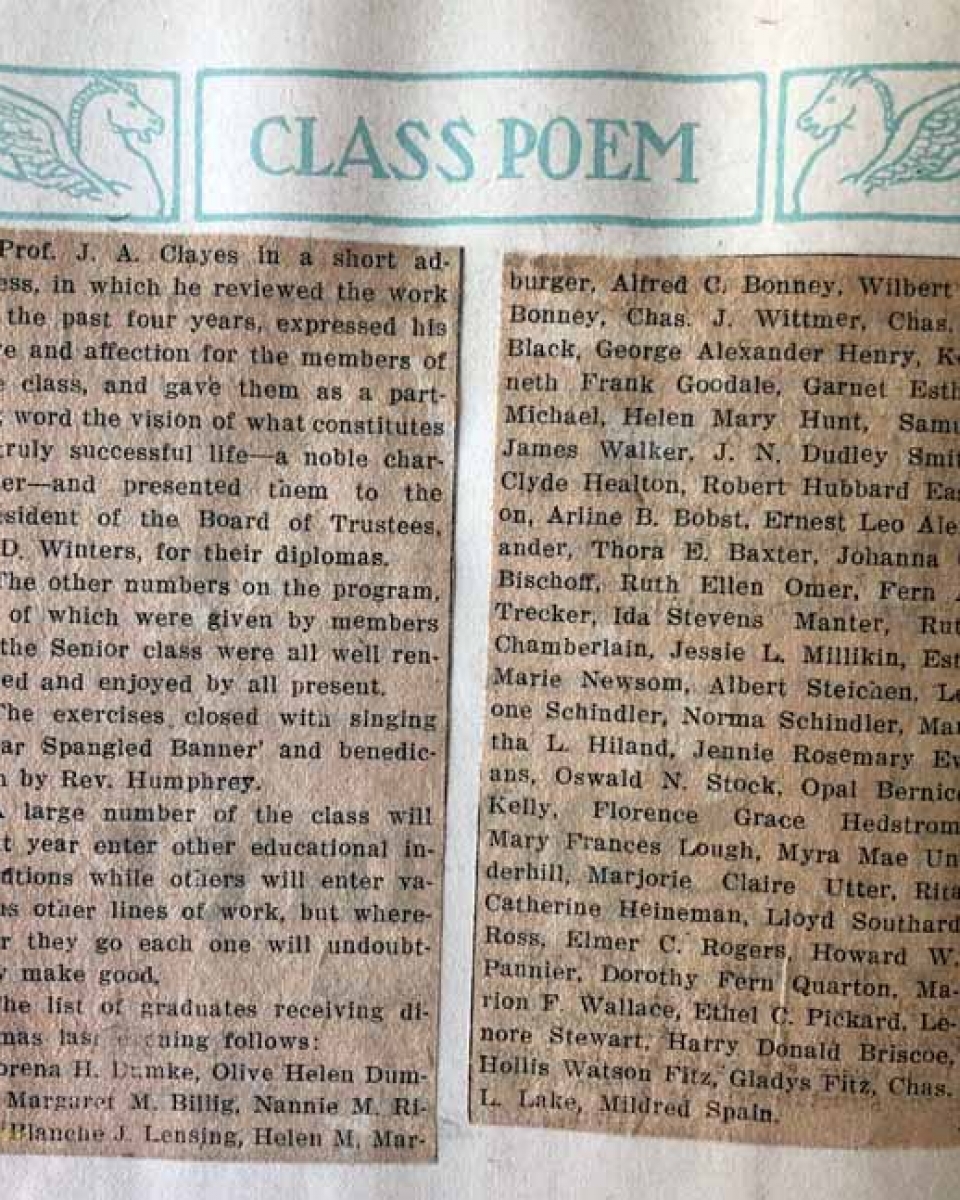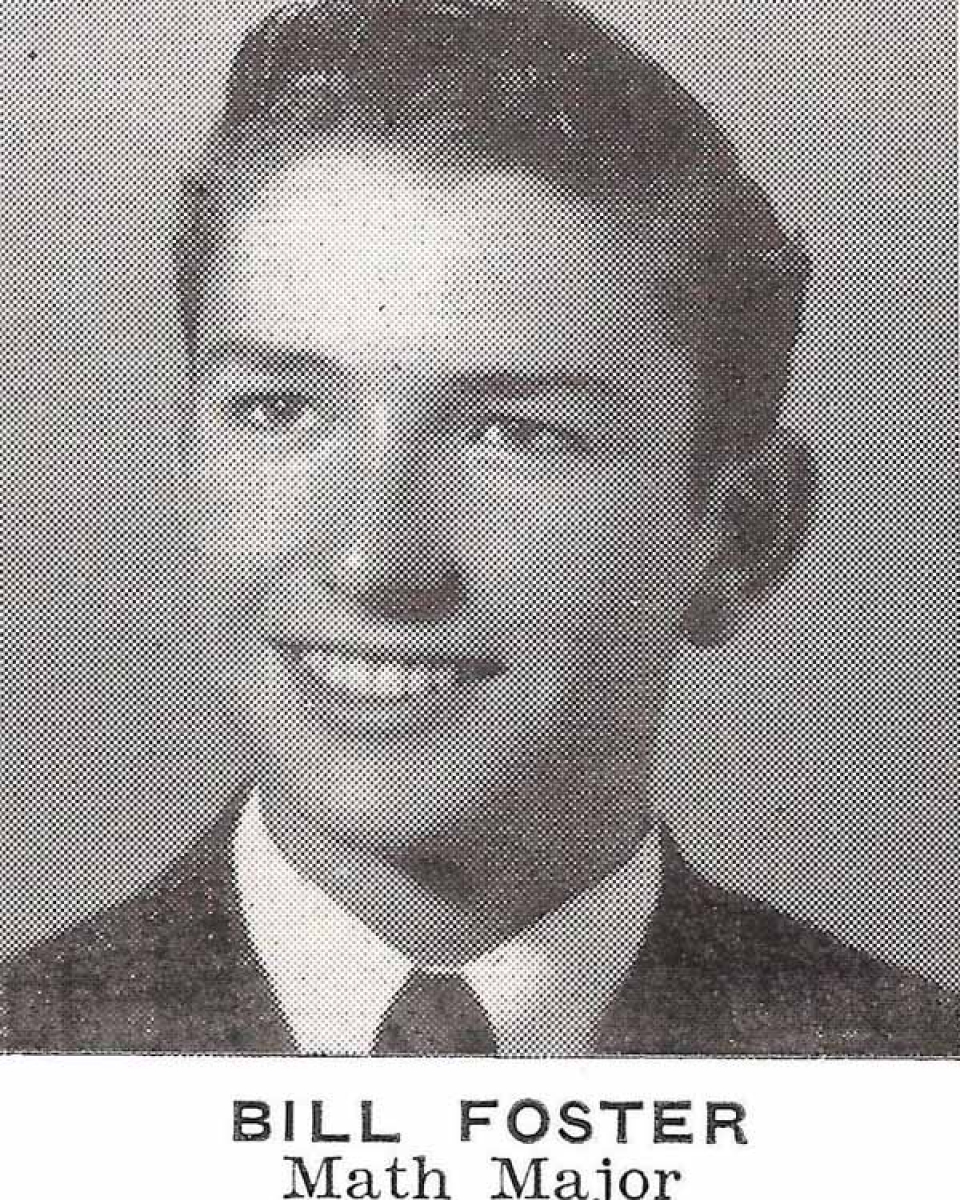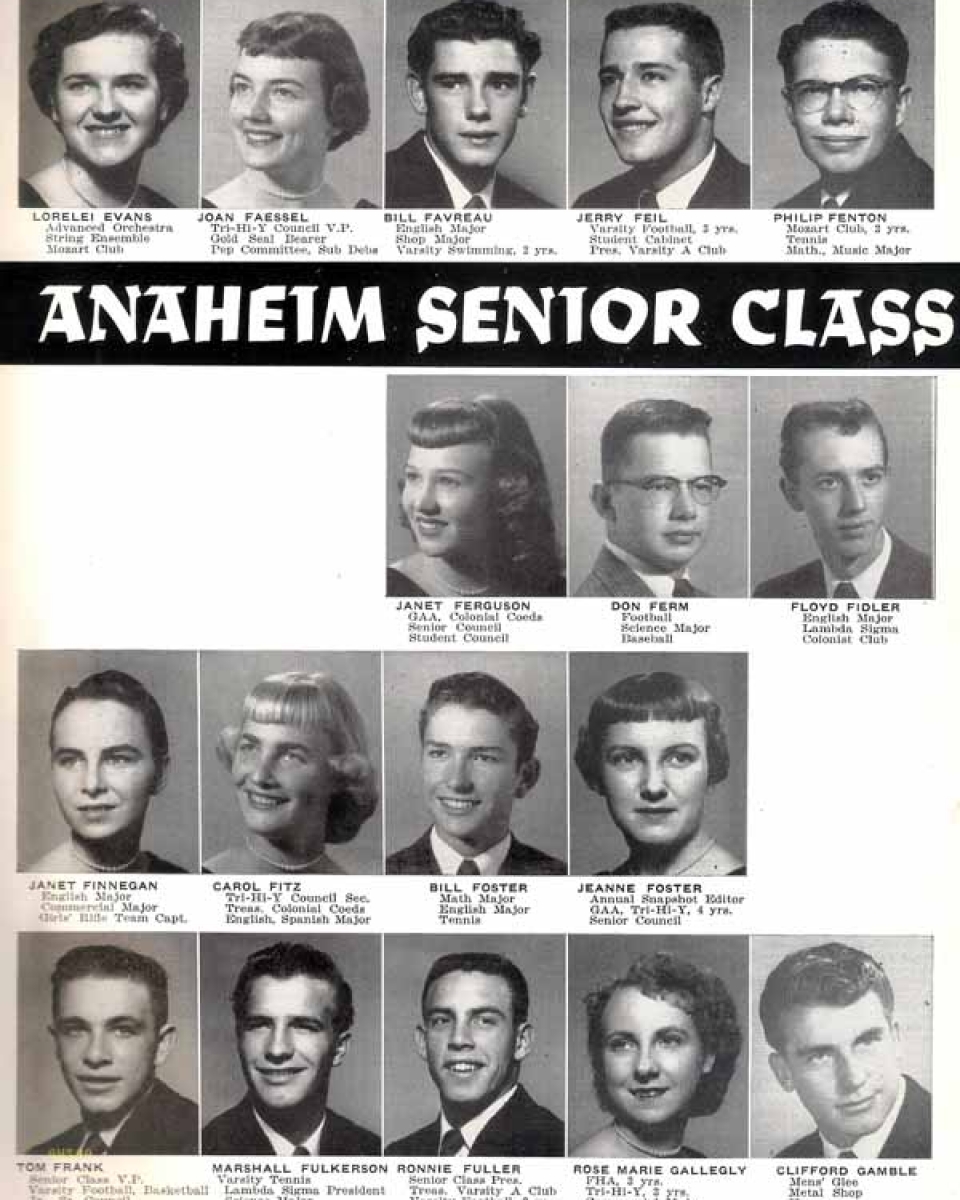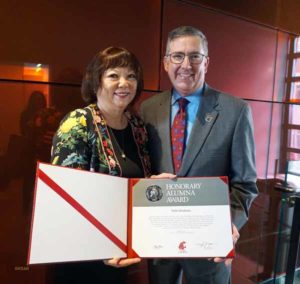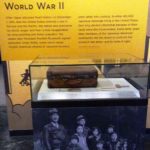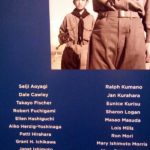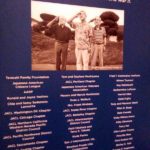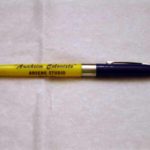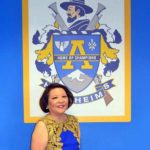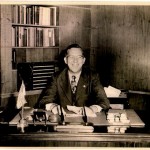Click on the image to read the latest edition of the AHSAA Gold and Blue Newsletter.
AHSAA Gold and Blue 2023 Spring Newsletter
Colonist WWII Fallen Hero Returns Home
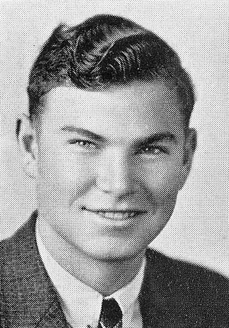 The remains of Class of 1937 Colonist John F. Minogue, who had been listed as missing in action since 1943, were return home for burial after being identified in 2022. He was buried April 20, 2023, next to his mother, Pearl Thessie Minogue Miller, at Loma Vista Memorial Park in Fullerton.
The remains of Class of 1937 Colonist John F. Minogue, who had been listed as missing in action since 1943, were return home for burial after being identified in 2022. He was buried April 20, 2023, next to his mother, Pearl Thessie Minogue Miller, at Loma Vista Memorial Park in Fullerton.
On Aug. 1, 1943, 2nd Lt. John F. Minogue, age 24, was shot down over Romania. But for nearly 80 years, he was among the fallen troops who could not be identified at the time.
Born May 1, 1919, Minogue played football for Anaheim Union High School and attended Fullerton College after graduating from AUHS in 1937. A Gold Star Flag was displayed in the window of his home at 506 Claudina Street, where he had lived with his mother until moving to Richfield, CA, 550 miles north of Anaheim, sometime before enlisting in the Army Air Corp on May 20, 1941.
By the end of 1941, Minogue earned his Army wings of gold and was sent to Europe. In the summer of 1943, he was assigned to the 328th Bombardment Squadron (Heavy), 93rd Bombardment Group (Heavy), 9th Army Air Force.
On Aug. 1, 1943, the B-24 Liberator bomber named “Euroclydon The Storm,” on which Minogue was co-pilot, was hit by enemy anti-aircraft fire and crashed during Operation Tidal Wave, the largest bombing mission against the oil fields and refineries at Ploiesti, north of Bucharest, Romania.
Piloted by Lt. Enoch Porter, “Euroclydon The Storm” was part of the first wave of the mission and was positioned as lead aircraft left wing. The bomber took a direct hit and was seen attempting to climb to 300 feet. The plane broke in midair before crashing in flames over a school at Plopu. Of the 11 crewmembers, three were taken POW, the bombardier bailed out but his parachute failed to open, and it is believed that two gunners also jumped with failing chutes. Five bodies were never recovered, and only two crew were initially identified.
More than 500 airmen died in this mission, and 54 planes were lost. All of the 93rd Bombardment Group earned the Presidential Unit Citation. Minogue was awarded, posthumously, the Distinguished Flying Cross for his role. He was also awarded an Air Medal and Purple Heart.
Minogue’s remains were buried as “unknown” in the Hero Section of the Civilian and Military Cemetery of Bolovan in Romania.
Following the war, the American Graves Registration Command (AGRC), the organization that searched for and recovered fallen American personnel, disinterred all American remains from the Bolovan Cemetery for identification. The AGRC was unable to identify more than 80 unknowns and those remains were permanently interred at Ardennes American Cemetery and Henri-Chapelle American Cemetery, both in Belgium.
In 2017, the Defense POW/MIA Accounting Agency (DPAA) began exhuming the remains of those believed to have died in Tidal Wave in an effort to identify them and, in August 2022, Minogue was announced as successfully named.
Minogue’s name is recorded on the Tablets of the Missing at the Florence American Cemetery, an American Battle Monuments Commission site in Impruneta, Italy, along with others still missing from WWII. A rosette will be placed next to his name to indicate he has been accounted for.
Euroclydon The Storm Crew
1Lt Enoch M. Porter Jr. – Pilot
2Lt. John F Minogue – Co-Pilot
Raymond P. Warner – Navigator
1Lt Howard Dickson
Fl. Of. Joe E. Boswell
1st/Lt. Jesse D “Red” Franks, Jr
T/Sgt.Frank C Ferrel
TSgt Bernard R Lucas
SSgt Earl L. Frost
AHS On Honor Roll for Contribution to Super Bowl History
The Super Bowl has become an star-studded event, and among those stars are Anaheim Colonists who have played a role in the epic gridiron match.
Fifty-six years ago, the Anaheim High School Drill Team appeared in the first Super Bowl and three Colonist grads have coached and played in five Super Bowls, placing AHS on the Super Bowl High School Honor Roll.
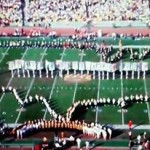
The Ana-Hi-Steppers carried flags representing all AFL and NFL teams in Super Bowl I. The U.S.A. outline map was created by two university bands. The team also performed in a pre-game show.
The award-winning 1967 Ana-Hi-Steppers Drill Team, wearing traditional blue and gold Colonial costumes complete with white wigs and tri-corner hats, performed along with the Grambling State University Marching Band and the University of Arizona Symphonic Band. Musician Al Hirt was the half-time headliner, along with two rocket men who were propelled over the field by jetpacks.
The Colonist Hi-Steppers shared the field that January day with such greats as Vince Lombardi, Bart Starr, and the colorful Hank Stram. The game was watched by 50 million TV viewers and football fans who packed the LA Memorial Coliseum. (Billed as the most watched event in television history, more than 10 million viewers are expected to watch Super Bowl 50, Feb. 7, at Levi Stadium in Santa Clara.)
The Class of 1967 also produced two football greats who are connected to what has become sport’s greatest spectacle. Gerry “Moon” Mullins starred in all four of the Pittsburgh Steelers’ first four Super Bowl championships (IX, X, XIII, XIV), and Jim Fassel was named NF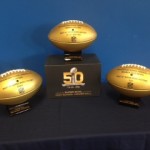 L Coach of the Year in his first season at the helm in New York, when he led the Giants to Super Bowl XXXV.
L Coach of the Year in his first season at the helm in New York, when he led the Giants to Super Bowl XXXV.
A third Anaheim football star, perhaps the school’s greatest player, Reuben Droughns from Class of 1996, played on special teams for the New York Giants in Super Bowl XLII.
To honor Anaheim High’s contribution to Super Bowl history, the NFL gifted the school with a three commemorative Wilson Golden Football imprinted with the names of Mullins, Fassel and Droughns.
Footage of the half-time show is available at: http://twentytwowords.com/nearly-every-super-bowl-halftime-show-since-1967-37-videos.
- Vintage drill team costumes were recoved by the AHSAA and are being preserved along with other Colonist memorabilia.
- The Anaranco documented the important accomplishments of Anaheim High.
Evolution of the Anaheim Colonist Mascot
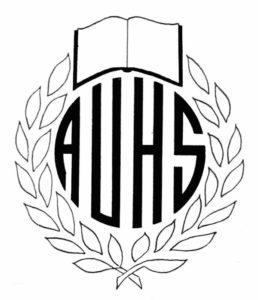 By the time Anaheim’s Central School was built and began holding high school classes in 1898, sports teams were being formed and cross-town rivalries were quickly established.
By the time Anaheim’s Central School was built and began holding high school classes in 1898, sports teams were being formed and cross-town rivalries were quickly established.
In 1900, football begins with the first recorded game played against Fullerton at Anaheim on Nov. 6. Anaheim wins 2-0. Local sports reporters began referring to Anaheim High teams as the “Mother Colonists.”
It wasn’t until November 1922 that an official mascot name was selected by Anaheim High’s staff and student body. In a spirited contest, the three top name choices were the “Homers,” “Pioneers,” and “Colonists.”
The school newspaper reported “At first the name “Homers” vied with “Colonists” in popularity. “Pioneers” was also popular. But “Colonists” was the final choice as the appropriate, dignified name for the representatives of the “Mother Colony.”
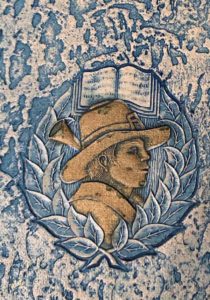 While the name was select, there was no visual depiction of the Colonist mascot until Principal Joseph Clayes, a talented artist who first joined the school staff as a teacher of art and commerce, designed the first logo of a pilgrim profile embedded in the book-topped laurel wreath.
While the name was select, there was no visual depiction of the Colonist mascot until Principal Joseph Clayes, a talented artist who first joined the school staff as a teacher of art and commerce, designed the first logo of a pilgrim profile embedded in the book-topped laurel wreath.
The Colonist logo first appeared on page 2 of the 1928 yearbook with a copyright notation. The Colonist pilgrim logo made its initial appearance on a yearbook cover the following year.
Prior to Claye’s design, the school’s logo (or crest) was a laurel wreath, topped by an open book, surrounding the school’s initials of AUHS. (Initially, the school’s name was Anaheim Union High School. Union was dropped in the 1960-61 school year as Anaheim was no longer the only high school in the district.
At some point, the Colonist mascot was named “Clem.” Then a “Connie Colonist” came on the scene.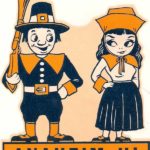
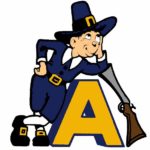 In the 1960s,
In the 1960s,
Clem Colonist took on a whole new look, resembling the City of Anaheim’s “Andy” mascot, which was designed by a Disney artist. While no documentation has been found to support this for the Anaheim High logo, the style certainly supports the claim. This mascot design has Clem leaning on a blunderbuss, a gun often associated with the Plymouth Colony Pilgrims.
In 1970, Vice Principal Gary Lindell created the Colonist shield logo, which is probably the most well-known design. It incorporates the tag line “Home of Champions,” reflecting the school’s numerous sports championships.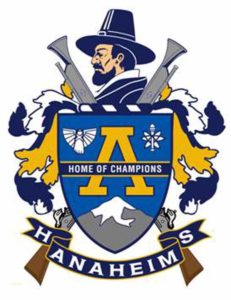
Yet another design, the “charging mascot,” was introduced in the 2000s. This logo is attributed to the Super Bowl success enjoyed by the New England Patriots. Many high school teams across the country began using variations of the “Patriot” logo. Anaheim follow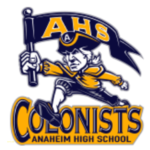 ed this trend with a design that has the Colonist mascot charging with an AHS-adorned flag. (This is standard clip art with the AHS or Colonist name inserted and not an originally crafted design.)
ed this trend with a design that has the Colonist mascot charging with an AHS-adorned flag. (This is standard clip art with the AHS or Colonist name inserted and not an originally crafted design.)
Just two years away from the school’s 125th anniversary, the evolution of the logo design continues.
Corona Virus Quarantine Motives Grad to Unpack Historic Photos
When Class of ’56 grad William “Bill” Foster began his Covid-19 quarantine, he knew it was the perfect time to tackle boxes of packed away photos that date back to the early 1900s and start organizing albums.
His project has unearthed some treasured photos of his mother, Arline Mary Foster (nee Bobst), also an Anaheim High grad from 1920.
Arline was born in Anaheim in 1902, and her family owned a small dairy and farm near Manchester (Santa Ana Freeway) and Crescent Avenue. Bill said the farm was “long gone” by the time he came along and he has no recollection of it.
Bill has an older brother, Richard, who also graduated from Anaheim High in 1944. Bill, Richard and their mother all attended and graduated from Loara Elementary School. Richard also had children who graduated from Anaheim, but Bill moved out of Anaheim by the time he was starting a family.
So, thanks to the quarantine, we’re able to share some photos and old newspaper articles from Arline’s albums, as well as Bill and Richard’s senior photos. He hasn’t finished going through all the boxes, so maybe he’ll find more treasures to share! Once A Colonist, Always A Colonist!
AHS Connection to the Japanese-American WWII Experience Comes Full-Circle
Sharing Her Family’s Unique History Becomes Life Work for AHS Alumna
Anaheim High Class of 1973 graduate Patti Hirahara, whose family came to Anaheim as part of the Japanese-American resettlement after WWII, is carrying her family’s story forward by sharing an acclaimed photo collection and other ephemerae preserved from their incarceration in a WWII Japanese relocation camp.
Her work is also helping illuminate Anaheim High’s connection to the Japanese-American WWII experience.
Patti’s father, grandparents and great-grandparents were moved from Yakima, Washington, to Wyoming’s Heart Mountain Relocation Center. From a secret darkroom underneath a camp barracks, Patti’s father, Frank, and grandfather, George, developed and printed 2000 photographs that chronicled the lives of the 10,000-population Heart Mountain camp.
(There were nine other camps built under the direction of President Franklin D. Roosevelt’s Executive Order 9066, which authorized the incarceration of 120,000 Japanese-Americans, including infants and children. Over two-thirds of them were U.S. citizens. Signed Feb. 19, 1942, the order was later called America’s “worst wartime mistake.”)
As a citizen of Japan, her grandfather George was not allowed to possess camera equipment. But Patti’s father Frank C. Hirahara, then a high school teenager, was a U.S. citizen and allowed to take photos with the family camera purchased from the Sears, Roebuck and Montgomery Ward catalogs.
While Frank was incarcerated, he played trumpet in the famous Heart Mountain George Igawa Dance Band and was photo editor of the Heart Mountain High School “Tempo” annual during his senior year in 1944.
When Frank passed away in 2006, he could not have imagined that his family’s history would allow historians and museums to create photographic collections and exhibits across the U.S. that would tell the tale of the Japanese immigration into the United States, their history in America, and the incarceration of Japanese Americans during WWII.
Thanks to Patti’s diligence, her ancestors’ experience became the subject of an Emmy-award winning documentary, “The Legacy of Heart Mountain,” and used as background historical material for the world premiere of the musical “Allegiance” at the Old Globe Theater in San Diego.
In addition, the family’s photo collection has been displayed in numerous exhibits, including being shown at the Smithsonian’s National Museum of American History and the FDR Presidential Library and Museum.
After he was released from the camp in 1945, he continued his education at Washington State University, where he earned a bachelor’s degree in electrical engineering in 1948.
In 2010, Patti donated the original negatives and photos to WSU. Funding from the National Park Service’s Japanese American Confinement Sites Grant Program allowed the University to preserve, clean and digitize the negatives for future generations. Click this link to access the collection.
For her work, Patti has received numerous awards and recognitions, including being named a WSU honorary alumna. Receiving the award was especially significant for her, as this year marks the 75th anniversary of when her father began taking photos in the camp.
“WSU’s history is unknown to many people, especially the fact that the university allowed Japanese-American students to continue their education during WWII,” she said. “It is an extreme honor to be recognized by my father’s alma mater and it has been a wonderful partnership with WSU over the last eight years.” She is the first Japanese American to receive the award since 1966.
Patti has worked more than six years locating many of the people in the photos. By sharing them with family descendants, she offered them a piece of history that they never knew existed. In addition, she’s spearheaded workshops, films and presentations during which she shared her family’s story and photo collection with hundreds of students and community members, as well as being a featured speaker at the FDR Presidential Library.
In 2009, the Anaheim Library’s Heritage Center held its first museum without walls exhibit documenting the Hirahara family’s legacy to the City.
Most recently, Patti’s has joined efforts with the Anaheim Library Heritage Center to identify and interview the 50 students of Japanese descent whose educations at Anaheim High were interruped when their families were forced to relocate to camps.
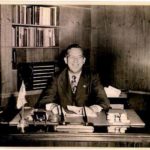 A particularly poignant part of the Anaheim High story is that the principal at this time, Dr. Paul Demaree, was born in Japan to missionary parents. He was especially vocal in speaking out against discrimination toward Japanese-Americans, a courageous position to take considering the war fervor at the time. Principal Demaree, who also served as the District’s superintendent, kept in touch with his Japanese-American students and encouraged them to continue their studies.
A particularly poignant part of the Anaheim High story is that the principal at this time, Dr. Paul Demaree, was born in Japan to missionary parents. He was especially vocal in speaking out against discrimination toward Japanese-Americans, a courageous position to take considering the war fervor at the time. Principal Demaree, who also served as the District’s superintendent, kept in touch with his Japanese-American students and encouraged them to continue their studies.
Ironically, the parents of today’s AUHSD Superintendent, Mike Matsuda, were both incarcerated in the same internment camp; his mother, Ruth Ikeda, was one of the students who had to leave Anaheim High during her freshman year.
- Smithsonian Exhibit at American History Museum
- Hirahara photos part of exhibit.
- George Hirahara’s softball seen at Smithsonian during AHSAA visit.
- Hirahara Family contributes to Smithsonian exhibit.
- Anaheim High connection to Japanese-American WWII experience
- Part of Patti’s Anaheim memorabilia collection
- Patti donated her family’s photo collection to Washington State University
- Patti Hirahara named honorary WSU alumna
- Patti graduated from AHS in 1973.
- AHS Student Body Card
- Patti’s school memorabilia was displayed in the Anaheim Heritage Center.
- Patti at Anaheim High
Colonist Fallen Hero Returns Home to Rest at Arlington
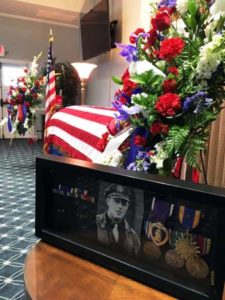 On a solemn, stormy day 74 years after making the ultimate sacrifice for his country, AHS Class of ’34 Colonist John Liekhus was buried with full military honors at Arlington National Cemetery.
On a solemn, stormy day 74 years after making the ultimate sacrifice for his country, AHS Class of ’34 Colonist John Liekhus was buried with full military honors at Arlington National Cemetery.
AHSAA Announces First Endowed Scholarship
- Paul H. DeMaree – 1941-1954 (13 years)
Gania (Demaree) Trotter, an Anaheim Union High School Class of 1944 graduate, along with other alumni, has established an endowed scholarship through the AHS Alumni Association to honor her father, Dr. Paul H. Demaree, who served as a AUHS teacher and administrator from 1925 through 1958.
The income from the endowment will provide annual scholarships for Anaheim High graduates to further their educations and advancement to professional careers. All alumni are invited to contribute to this fund as a centerpiece of continuing care for their alma mater. Many former AUHS students may personally remember Dr. Demaree or may have parents who were students during his years at AUHS.
Demaree’s tenure at Anaheim High started when he joined the AUHS staff as a teacher of social studies and to coach football and baseball. In 1926, Demaree’s “B” team had the best record of all the AUHS teams. Upon the death of Joseph A. Clayes, who served as principal for nearly 22 years from 1919 to 1941, the School Board rehired Demaree, who had left Anaheim for three years to serve as principal of Capistrano High School.
At the first assembly of the 1941 school year, Demaree reminded the student body that “principal” ended in “pal,” a word he hoped would describe his relationship with the students. Not only was he a friend and father figure to Anaheim pupils and teachers, four of his students were his own children, including daughters Kathleen (’38), Gania (’44), Ruth (’45) and and son Dan (’50).
It was most definitely a family affair for Demaree and his wife, Mary, who often entertained students and teachers at their home and, for many years, prepared and served a turkey dinner to the faculty and staff as a prelude to the school holiday break.
He was also a beloved figure in the community and gave leadership to the Rotary Club, his church and the YMCA. Mr. and Mrs. Demaree worked each summer at the YMCA’s Camp Osceola in the San Bernardino Mountains, where they would cook elaborate meals for camp’s teenage occupants. Memorable to many from that era were the hot caramel yeast rolls the Demarees baked each morning for the hungry campers.
An active board member of the local YMCA, he also found time to be counselor for the Blue and Gold Hi-Y Club of more than 100 members. Six of them jointly shared valedictorian honors at graduation in 1950.
Demaree also organized a Toastmaster’s program to encourage public speaking skills in the community. He is credited with being one of the original founders of Toastmasters International. He also founded a Junior Toastmasters program at the high school.
The start of World War II dramatically changed the atmosphere of AUHS when 50 students of Japanese descent were forced to relocate with their families to concentration camps. Demaree was vocal in speaking out against the discrimination towards Japanese-Americans, a very courageous position to take considering the war fervor at the time. Demaree kept in touch with many Japanese-American students who were interred during the war and encouraged them to continue their studies.
Life at the high school was further affected as students left for jobs in the defense industry and to serve in the military. Demaree asked all his students to carry identification cards in case of bombings. On the first day of school in 1942, Principal Demaree called the student body together with all of them being sworn in the Victory Corps. Students participated in scrap metal drives and held contests to sell the most war bonds and stamps. All teachers were required to take a 10-week course in first aid.
When a manpower shortage affected the 1943 harvest, Demaree responded to pleas for student volunteers from local farmers by declaring half day schedules (called the Victory Schedule) from the beginning of school in September through mid-October.
The popular Nutrition Period of today originated in 1943, when Demaree introduced a 10-minute “relaxation period” because too many students were coming to school without eating until noon. He felt their health and learning efficiency were impaired.
The war in Europe was over just as the Class of 1945 was getting ready to graduate. The Japanese surrendered in August, leaving a sense of freedom in the United States that had not been felt for years. Demaree held the first assembly on Sept. 24 at which he introduced the new student body president who read the list of AUHS students who had died in the war.
The next 10 years saw the City of Anaheim evolve from a sleepy farm community to a post-war boom town. Change was inevitable for the school as well. For the first time since the District’s establishment, Anaheim High’s principal vacated his post to become the full-time superintendent. Demaree and his staff kept up a frantic pace of buying land and building schools to keep ahead of the educational needs of the children moving into Anaheim. The District asked Anaheim residents to approve a bond measure for $6 million to help accomplish this monumental task.
Demaree retired in 1958 when the building program was in full swing. Yet even after retirement, Demaree continued to be involved in the dedication of new schools in the AUHSD. Throughout his time as Anaheim’s principal and the District superintendent, Demaree provided steady leadership and support to the students and teachers, continually espousing the “one family” concept for the faculties of schools as new ones opened.
Demaree left behind a legacy as one of Anaheim High’s most beloved principals, serving during a time of amazing transformation of the school system and its students. He will continue to serve as a benefactor to the students of Anaheim High School through the newly established “Dr. Paul Demaree Endowed Scholarship.”
To donate to this fund, which will be managed by the Scholarship Committee of the AHSAA, a non-profit 501(c) 3 corporation, please send a donation to the AHSAA, P.O. Box 389, Anaheim, CA, 92815, with the notation that the donation is to be placed in the Paul H. Demaree Endowment fund. Questions may be address to anaheimalumni@yahoo.com. For more information on the AHSAA, visit www.anaheimcolonists.com.

